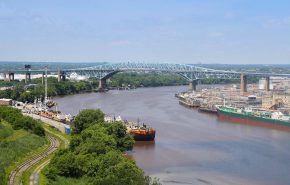According to The American Society of Civil Engineers (ASCE), America scored a D+ on its cumulative GPA in the 2013 Report Card for America’s Infrastructure. Issued every four years, the Report Card illustrates the conditions and performance of our nation’s infrastructure in an easy-to-understand A to F school report card format. Based on current trends, the ASCE estimates we will need $3.6 trillion in investment to achieve a state of good repair (a B grade) in each infrastructure category by 2020.
Infrastructure is critical to preserving healthy, vibrant communities and long-term economic growth, but the struggle we face is having the funds to tackle these infrastructure investments. In this final article of our Road to Recovery Series, we speak with Owen Beitsch, PhD, FAICP, CRE, Senior Director and adjunct faculty member at the University of Central Florida. Owen shares his thoughts on investing in community infrastructure.
What dividends could communities see as a result of infrastructure investment?
Owen: In theory, every dollar invested in infrastructure is paid back many times over from the commercial activity that occurs as a result of that improvement. Our manufacturing sector, our services sector, and our entire economy is dependent on infrastructure. Whatever we produce as a country, whether it’s knowledge or products, requires infrastructure. Since the 1950s, our country has taken a position that for the economy to grow, infrastructure needs to be stable and meet the needs of industry. That’s the model that China and India follow, but those countries are spending many times the infrastructure dollars that we are, which shows that creating and maintaining strong, healthy infrastructure is a model that has been recognized now by other places as the means to be wealthier places tomorrow. If we continue to ignore infrastructure investments, we do so at the peril of what our future economy could look like.
How do local governments develop strategies for increasing investment in any sort of infrastructure?
Owen: First, communities need to be visionary and think about tomorrow. With every investment, communities must ask, “Will it pay for itself and gain benefits over the next several years?” The idea is to think long-term, which means beyond an elected official’s immediate term in office. Secondly, every community needs to recognize its strengths. And thanks to social media and media in general, local governments are now more in touch with their resources and assets than ever before. So there shouldn’t be a lot of question about what a local community’s strengths are anymore. Every community has an opportunity to be its own place—a place with a future as opposed to just a past—and that is based on its strengths.
In your opinion, what areas of community infrastructure are the most important to focus on?
Owen: We can define the term infrastructure very broadly. We usually mean roads, water, and sewer. If you’re more broadminded, you also think of things like conservation areas and schools. In order of importance, I think a complete community needs to focus on the following infrastructure elements:
- Water—In my mind, water is the most important resource. Because of population growth, we’re becoming increasingly sensitive to how we control and protect our water resources, and we’re slowly starting to think about how we reuse and recapture some of the water that we waste. Local governments need to recognize the importance of water as a valuable commodity and price it according to who uses it, when it’s used, and how it gets used. By charging adequately for it, communities can not only recover the cost of water distribution, but also generate revenue to reinvest back into the community for other needs. By better regulating and controlling the flow of water, communities will achieve a business, environmental, and infrastructure goal all at the same time.
- Roads—Roads support future investment. We’re not spending or doing enough to preserve our existing roads, so communities need to turn their attention to figuring out ways to preserve the investments that have already been made, which means placing more emphasis on preserving, upgrading, and maintaining existing roads. To accomplish this, local governments have to create more funding options. Examples include implementing local gas tax options, creating special district financing, and establishing tax increment districts.
- Wastewater—Just like water, wastewater can also be priced, and I don’t think communities do a good job of that. If it was properly priced, we’d recycle it better. Wastewater is normally charged through the utility. With this, the utility becomes more profitable and more money comes back to the local government if they own the utility.
Knowing communities need to do more with less, what ideas can you share to help them make infrastructure projects happen?
Owen: Local governments are being asked to do things differently, and those that succeed in the next decades will be the ones who actively engage with their citizens and businesses, do more for less money, and get creative. Getting creative may mean reaching out to the private sector and engaging in public-private partnerships (P3s), like what Tom Kohler talked about in our last Road to Recovery article. Communities will also need to make better use of the resources they control: for example, utilities, which are almost always water, sewer, and sometimes electrical. For local governments fortunate enough to own their own utilities, if they operate them as a separate business unit, these utilities can provide financial resources back to the local community.
There’s no question that since the recession, communities are under severe financial duress. Now that we’re trying to recover, we’re spending less and our infrastructure is in a state of declining health and condition—the 2013 Infrastructure Report Card clearly demonstrates that. But the Report Card also reveals something else—that when infrastructure investments are made and projects move forward, the grades rise. Because we did, after all, modestly inch our overall GPA from a D to a D+, and this happened through increased investment in several categories, including solid waste, drinking water, wastewater, roads, bridges, and rail. Through leadership and creativity, communities can universally continue to improve the current conditions of our nation’s infrastructure and strive to raise our GPA.
For more advice on infrastructure investment, contact Owen Beitsch at 407.423.8398.


